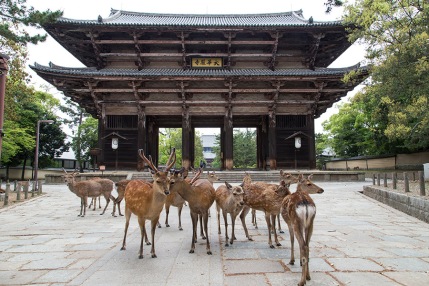By Katy Yocom, Spalding MFA Associate Director

Even in Kyoto—
Hearing the cuckoo’s cry—
I long for Kyoto.
Matsuo Basho
Each summer, the Spalding MFA in Writing program travels overseas to study creative writing while exploring literature and art across cultures. Our Summer 2018 residency takes place in Kyoto.
Once the imperial capital of Japan and still the heart of Japanese culture, Kyoto is the historic home of Kabuki theater, the locus of Japan’s TV and film industry, the stomping grounds (and muse) of seventeenth-century haiku master Basho, and the setting of Yukio Mishima’s great 20th-century novel The Temple of the Golden Pavilion.
historic home of Kabuki theater, the locus of Japan’s TV and film industry, the stomping grounds (and muse) of seventeenth-century haiku master Basho, and the setting of Yukio Mishima’s great 20th-century novel The Temple of the Golden Pavilion.
Curriculum and Cultural Exploration
Faculty-led workshops form the backbone of residency. Our Kyoto faculty include Kirby Gann, fiction; Greg Pape, poetry; Fenton Johnson, creative nonfiction; Edie Hemingway, writing for children and young adults; Larry Brenner, dramatic writing. Kathleen Driskell is program director, and I’ll be there as associate director.
Students also attend craft lectures, readings, and sessions on publishing; read and discuss Japanese literature; and try their hand at a cross-genre exercise. After residency, students work one-on-one with a faculty mentor in an independent study focused on fiction, poetry, creative nonfiction, writing for children and young adults, playwriting, or screenwriting.

Classes take place in a city-center hotel near Kyoto Station, a few minutes’ walk from our hotel. Guided cultural explorations include a tour of literary Kyoto, a half-day excursion to Nara, and a trip to Hiroshima by bullet train. We’ll take in a Kembu sword-dancing demonstration and stroll through the Gion performing arts district. Travelers can also opt to attend a traditional Japanese theater performance.

The summer residency is open to students, alumni, and guest travelers. Read on for a peek at the day-by-day itinerary.
Itinerary
July 11 or 12: Depart on an overnight flight to Kansai International Airport (KIX) in Osaka, arriving July 13.
July 13: Arrive in Osaka. Transfer by shuttle to our hotel in Kyoto.
July 14: Sleep as much as you can, then gather for our opening dinner.
July 15: Classes begin with our opening session and Program Book in Common discussion. Workshop begins this afternoon.
July 16: Morning classes. This afternoon, we visit Konpukuji Temple, where Basho once stayed, and the Temple of the Golden Pavilion, eponymous setting of the novel by Yukio Mishima.
July 17: Full day of classes.
July 18: Full day of classes.
July 19: Full-day cultural excursion to Hiroshima via bullet train. We will visit the Peace Memorial Park, Atomic Bomb dome, Children’s Memorial, and Peace Memorial museum.
July 20: Morning classes. The afternoon is free to explore Kyoto on your own. An optional excursion takes us to a traditional Japanese theatre performance.

Todaji Temple
July 21: This morning, we take a half-day excursion to Nara Park and the Todaji Temple, a UNESCO World Heritage site. Afterward, we return to Kyoto for a free afternoon.
July 22: Morning classes. After our graduation ceremony, we take in a Kembu sword dancing demonstration and tour the Gion performing arts district. We say our farewells at the closing dinner.
July 23: Fly back to the States or continue your travels. Airport shuttles will be timed to accommodate flights from Osaka (KIX) recommended by WorldStrides.

Konpukuji Temple
What’s included in the travel package?
- A shared hotel room for 10 nights at the New Miyako Hotel in central Kyoto
- Opening and farewell dinners; breakfasts daily
- Half-day tours to Nara and literary Kyoto
- Full-day excursion to Hiroshima by bullet train
- Kembu sword-dancing demonstration and walking tour of Gion performing arts district
- Airport transfers on July 13 and 23
- Customary gratuities for local guides and assistants
- Basic trip insurance at no extra charge
International flights are not included, but you can book flights through WorldStrides, our travel provider, if you like.
How much does tuition cost?
Tuition is the same as in spring and fall semesters: $560/credit hour, or $8,400 for the semester. For graduating students, tuition for the residency is $2,800.
How much does the ground package cost?
Current MFA students who sign up for travel by January 5 pay $3,455 for the ground package, based on shared occupancy. (For incoming students, the same discount is available until March 10.) After the discount period, the student travel package is $3,839.
Alumni and guests pay $3,839 for the ground package, based on shared occupancy.
Single room upgrades are available for an additional $1,326.
What’s the deadline to sign up for travel?
For current students, the deadline is February 1.
For prospective students, the application deadline for admission to the MFA program is February 1. March 20 is the final day to enroll for travel.
Can I cover travel costs using federal student loans?
Most students, including graduating students, can use student loans to cover travel expenses. It is your responsibility to ensure you have enough in loans coming to cover travel costs.
Are there any new pre-residency requirements?
Yes. The introductory workshop and Genre Book in Common sessions convene via Zoom videoconference Sunday, June 24 (time TBA). Students should ensure they can attend this mandatory meeting before registering for the residency. In addition, all graduating student lectures will be delivered online.
How do I sign up?
Registration opens soon! Current students will receive an email with registration details, and both current and prospective students are welcome to contact me with any questions.


Katy Yocom’s fiction, poetry, essays, and journalism have appeared in Salon, The Louisville Review, 2nd & Church, and elsewhere. The 2016 recipient of the Siskiyou Prize for New Environmental Literature, she holds an MFA in Writing from Spalding University.
